Every day, the gaming industry is evolving at a rapid pace, along with the rapid growth of international consumer base. For game players, network and server latency can result in slow responses and being disconnected from the game itself. Hence, it has become a primary objective for the gaming industry to address these issues to enhance players' experience. Reliable servers, real-time data analysis and low-latency are essential for high-quality content and outstanding player experience.
This makes gaming a natural fit to run on cloud. Moreover, gaming companies no longer need to estimate the game servers they will need or even to make additional purchases in advance, as cloud computing offers flexible and scalable infrastructure.
Mobile gaming is now the largest segment of the gaming industry. With modern mobile technologies developed enough to handle medium-to-heavy workload games, many console gaming companies have entered the mobile segment. Mobile gaming tends to lean toward innovation, VR/AR, mobility, connectivity, and even going global. The underlying architecture for mobile gaming should be able to handle heavy workload and global connectivity while keeping costs at a minimum, making cloud computing the best choice for mobile gaming companies.
In 2016, Supercell launched a new game - Clash Royale, which laid the benchmark of the global server architecture in the gaming industry. In China, Clash of Kings, a game developed by Elex Technology, also achieved remarkable success. Following the success ladder of these games, many mobile gaming companies have chosen global cloud server architecture as a default solution to going global.
The following architecture is applicable to browser games, mobile games, and console games. It is constructed by two main modules: client services and operation services.
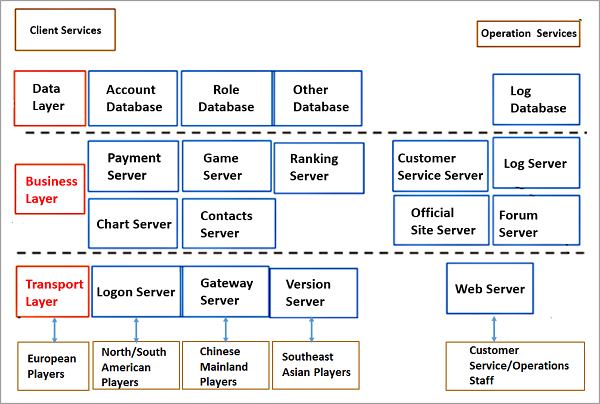
The architecture of Global Server Game Acceleration (or Global Accelerator) is built with the centralized game servers deployed in a single region, and edge locations deployed worldwide with the accelerated public network access. Players are geographically routed to the closest edge locations through Express Connect. This aids to minimize the latency, ensures high-quality performance and availability and to realize the global acceleration.
Currently, the prime pain area of global server games is the unfair gaming experience caused by different network latencies of players located in different regions. The technical complications such as price and quality variations of dedicated network connection from the third-parties, the high O&M costs involved in the worldwide edge location deployment, complex proxies are to name a few.
Game developers may encounter the following problems:
These problems make Alibaba Cloud Mobile Accelerator the most appropriate fit to resolve the "last mile" acceleration between clients and edge locations. See the following figure.
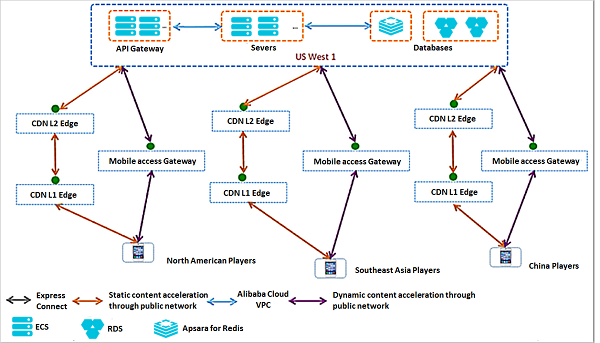
With Alibaba Cloud Global Acceleration, you do not have to manually configure content delivery acceleration to edge locations, which can be complicated, and requires longtime debugging. Global Acceleration ensures you the high availability, scalability, performance, and flexible routing.
Basically, Global Acceleration provides the point-to-point acceleration by using EIPs (elastic IP addresses) to map the ECS instances or VPC Server Load Balancer instances on your centralized servers to the public network. Global Acceleration speeds up the cross-region and cross-country connection to the servers, as shown in the following figure:
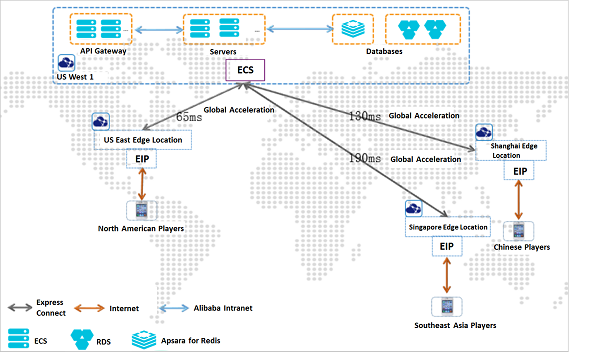
By combining Mobile Acceleration with Global Acceleration, we can accelerate the entire data path from the server to the client. In this solution, Mobile Acceleration speeds up the connection between clients and edge locations based on dynamic routing, while Global Acceleration speeds up the connection between the centralized servers and edge locations through Express Connect. See the following figure.
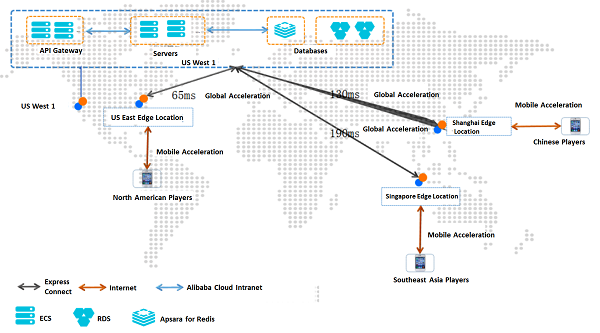
Based on the market research, in-depth discussion with our clients, and our own research on game architectures, we have designed and developed the following four architectures for global server games.
For global server games, fully-centralized deployment is the preferred choice of architecture for games that are not sensitive to network latency. In this architecture, the game access layer, business logic layer, and data layer are all centrally deployed in the same region. Players across the world, access the game over the Internet. The following figure shows the deployment architecture.
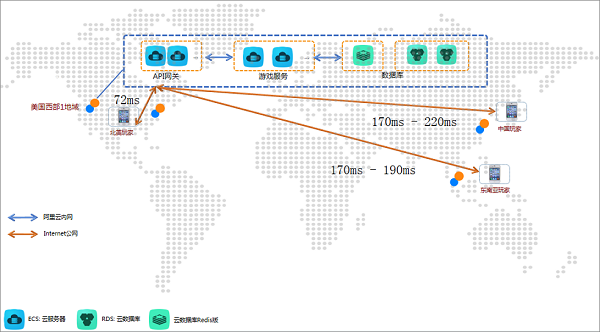
Note: For this architecture, we recommend the c5 family of computing-type instances. This instance type can support most game services that are not sensitive to network latency.
Applicable Scenarios
This architecture is suitable for global server games where players are concentrated in a certain region and the gameplay method is designed to be insensitive to network latency. If your preliminary game server architecture design is not suitable for the distributed deployment (for example, if no data synchronization mechanism is set in the logic architecture), you must select fully-centralized deployment when you launch your game.
Architecture advantages and disadvantages
In this architecture, the game access layer, business logic layer, and data layer are centrally deployed in a single region. Then, Global Acceleration is deployed on the Alibaba Cloud nodes for the regions you need to cover.After using intelligent DNS for scheduling, players in the various regions automatically access the game from the nearest node. Alibaba Cloud Express Connect provides an intranet connection between the game service and the various access points. The following figure shows the deployment architecture.
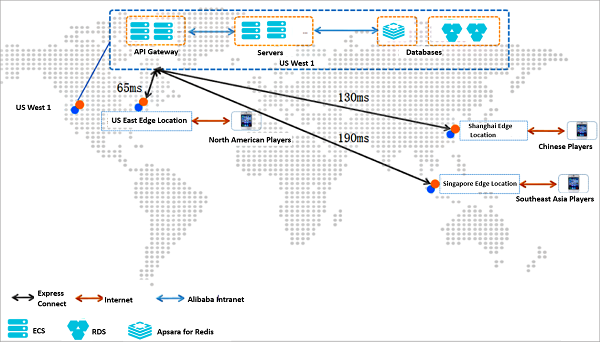
Note: We recommend using the sn1ne family of computing network enhanced instances. This instance type is an enhanced network model, which can meet the architecture's low-latency needs.
Applicable scenarios
This solution is appropriate for game server architectures that are unsuitable for the distributed deployment. It is a better choice for operators who want to cover as many regions as possible, while keeping the game's network latency below 200ms.
Architecture advantages and disadvantages
In this architecture, the data layer is centrally deployed in a single data center. Then, the game access layer, business logic layer, and cache layer are deployed in each of the regions that must be covered. The distributed architecture is shown in the following figure.
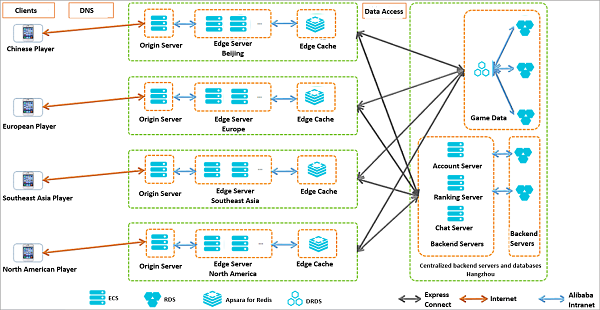
Note: We recommend using one of the following two instance type families:
Applicable scenarios
This architecture is suitable for games where players mostly interact with others in the same region and that have high requirements for network latency (for example, below 120ms, the minimum latency noticeable by human eyes). This architecture is a good choice for action games that want to equally cover all regions of the world.
Architecture advantages and disadvantages
Key design aspects
This section gives a detailed description of several key design aspects.
The player data read/write frequency is high and a large proportion of records have a single line. Therefore, it is best to use distributed storage architecture. For example, you can use the Alibaba Cloud DRDS and ApsaraDB for RDS products for a database and table-based splitting. This avoids the performance bottleneck of a single database instance.
For example, based on the distribution of Alibaba Cloud data centers, you could deploy access nodes in South China, North China, Southeast Asia, Europe, and North America. Specifically, you can deploy access services in the China East 2, China North 2, Singapore, Germany, and the East US regions.
For example, you can use the Alibaba Redis product for caching, allowing you to implement data caching and persistence. In this way, you do not lose data even if the leased line connection is unavailable.
In this architecture, the game logic and game data are deployed in a distributed manner. Only global game services and data are centrally deployed. This architecture is suitable for games with low read/write frequencies and less-strict network latency requirements. The following figure shows the deployment architecture.
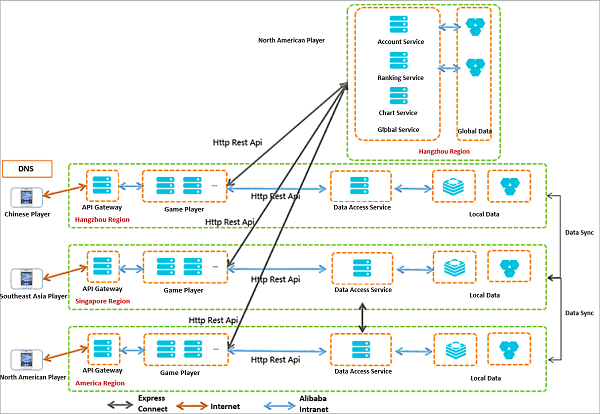
Note: We recommend using one of the following three instance type families:
Applicable scenarios
This architecture is suitable for games with high network latency requirements, a great deal of interaction between players in different regions, equivalent coverage in all regions, and a complete data synchronization mechanism in the game architecture.
Architecture advantages and disadvantages
Key design aspects
This section gives a detailed description of several key design aspects.
Docker Container Resource Management: CPU, RAM and IO: Part 3

2,593 posts | 790 followers
FollowAlibaba Clouder - March 3, 2021
Alibaba Clouder - March 15, 2020
Alibaba Clouder - March 15, 2019
Alibaba Cloud Community - October 8, 2023
Alibaba Clouder - April 7, 2021
Alibaba Clouder - January 13, 2021

2,593 posts | 790 followers
Follow ECS(Elastic Compute Service)
ECS(Elastic Compute Service)
Elastic and secure virtual cloud servers to cater all your cloud hosting needs.
Learn MoreLearn More
 CDN(Alibaba Cloud CDN)
CDN(Alibaba Cloud CDN)
A scalable and high-performance content delivery service for accelerated distribution of content to users across the globe
Learn MoreMore Posts by Alibaba Clouder